Stewart J. Calculus
Подождите немного. Документ загружается.

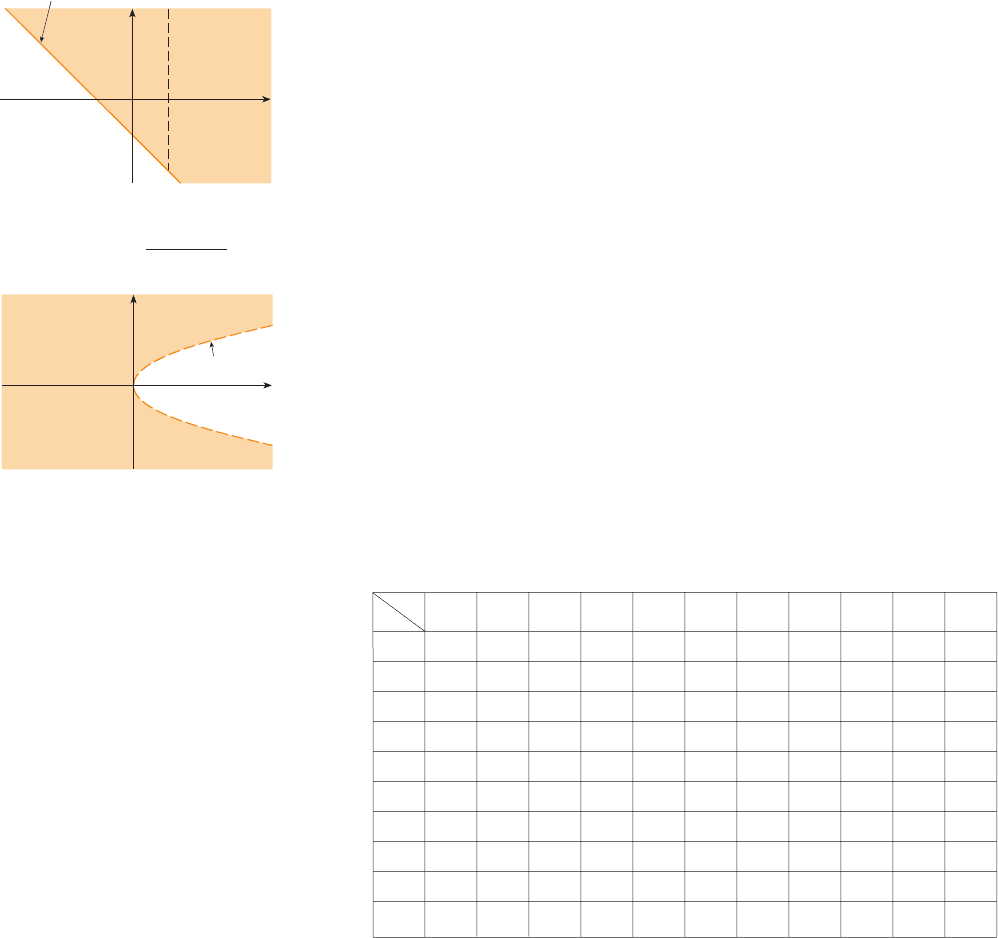
The expression for makes sense if the denominator is not 0 and the quantity under the
square root sign is nonnegative. So the domain of is
The inequality , or , describes the points that lie on or above
the line , while means that the points on the line must be
excluded from the domain. (See Figure 2.)
(b)
Since is defined only when , that is, , the domain of is
. This is the set of points to the left of the parabola . (See
Figure 3.)
M
Not all functions are given by explicit formulas. The function in the next example is
described verbally and by numerical estimates of its values.
EXAMPLE 2 In regions with severe winter weather, the wind-chill index is often used to
describe the apparent severity of the cold. This index W is a subjective temperature that
depends on the actual temperature T and the wind speed . So W is a function of T and ,
and we can write . Table 1 records values of W compiled by the NOAA
National Weather Service of the US and the Meteorological Service of Canada.
For instance, the table shows that if the temperature is and the wind speed is
50 km兾h, then subjectively it would feel as cold as a temperature of about with
no wind. So
M
EXAMPLE 3 In 1928 Charles Cobb and Paul Douglas published a study in which they
modeled the growth of the American economy during the period 1899–1922. They con-
f 共⫺5, 50兲 苷 ⫺15
⫺15⬚C
⫺5⬚C
4
⫺2
⫺7
⫺13
⫺19
⫺24
⫺30
⫺36
⫺41
⫺47
3
⫺3
⫺9
⫺15
⫺21
⫺27
⫺33
⫺39
⫺45
⫺51
2
⫺4
⫺11
⫺17
⫺23
⫺29
⫺35
⫺41
⫺48
⫺54
1
⫺5
⫺12
⫺18
⫺24
⫺30
⫺37
⫺43
⫺49
⫺56
1
⫺6
⫺12
⫺19
⫺25
⫺32
⫺38
⫺44
⫺51
⫺57
0
⫺6
⫺13
⫺
20
⫺26
⫺33
⫺39
⫺46
⫺52
⫺59
⫺1
⫺7
⫺14
⫺21
⫺27
⫺34
⫺41
⫺48
⫺54
⫺61
⫺1
⫺8
⫺15
⫺22
⫺29
⫺35
⫺42
⫺49
⫺56
⫺63
⫺2
⫺9
⫺16
⫺23
⫺30
⫺36
⫺43
⫺50
⫺57
⫺64
⫺2
⫺9
⫺16
⫺23
⫺30
⫺37
⫺44
⫺51
⫺58
⫺65
⫺3
⫺10
⫺17
⫺24
⫺31
⫺38
⫺45
⫺52
⫺60
⫺67
T
v
5 10152025304050607080
5
0
⫺5
⫺10
⫺15
⫺20
⫺25
⫺30
⫺35
⫺40
Wind speed (km
/
h)
Actual temperature (°C)
W 苷 f 共T, v兲
vv
x 苷 y
2
D 苷 兵共x, y兲
ⱍ
x
⬍
y
2
其
fx
⬍
y
2
y
2
⫺ x ⬎ 0ln共y
2
⫺ x兲
f 共3, 2兲 苷 3 ln共2
2
⫺ 3兲 苷 3 ln 1 苷 0
x 苷 1x 苷 1y 苷 ⫺x ⫺ 1
y 艌⫺x ⫺ 1x ⫹ y ⫹ 1 艌 0
D 苷 兵共x, y兲
ⱍ
x ⫹ y ⫹ 1 艌 0, x 苷 1其
f
f
892
||||
CHAPTER 15 PARTIAL DERIVATIVES
FIGURE 2
œ„„„„„„„
x-1
x+y+1
Domain of f(x,y)=
x
0
y
_1
_1
x=1
x+y+1=0
FIGURE 3
Domain of f(x,y)=xln(¥-x)
x
0
y
x=¥
TABLE 1
Wind-chill index as a function of
air temperature and wind speed
N THE NEW WIND-CHILL INDEX
A new wind-chill index was introduced in
November of 2001 and is more accurate than the
old index at measuring how cold it feels when
it’s windy. The new index is based on a model of
how fast a human face loses heat. It was devel-
oped through clinical trials in which volunteers
were exposed to a variety of temperatures and
wind speeds in a refrigerated wind tunnel.

sidered a simplified view of the economy in which production output is determined by
the amount of labor involved and the amount of capital invested. While there are many
other factors affecting economic performance, their model proved to be remarkably
accurate. The function they used to model production was of the form
where P is the total production (the monetary value of all goods produced in a year),
L is the amount of labor (the total number of person-hours worked in a year), and K is
the amount of capital invested (the monetary worth of all machinery, equipment, and
buildings). In Section 15.3 we will show how the form of Equation 1 follows from cer-
tain economic assumptions.
Cobb and Douglas used economic data published by the government to obtain
Table 2. They took the year 1899 as a baseline, and P, L, and K for 1899 were each
assigned the value 100. The values for other years were expressed as percentages of
the 1899 figures.
Cobb and Douglas used the method of least squares to fit the data of Table 2 to the
function
(See Exercise 75 for the details.)
If we use the model given by the function in Equation 2 to compute the production in
the years 1910 and 1920, we get the values
which are quite close to the actual values, 159 and 231.
The production function (1) has subsequently been used in many settings, ranging
from individual firms to global economic questions. It has become known as the
Cobb-Douglas production function. Its domain is because
L and K represent labor and capital and are therefore never negative.
M
EXAMPLE 4
Find the domain and range of .
SOLUTION The domain of is
which is the disk with center and radius 3. (See Figure 4.) The range of is
Since is a positive square root, . Also
So the range is
M
兵z
ⱍ
0 艋 z 艋 3其 苷 关0, 3兴
s
9 ⫺ x
2
⫺ y
2
艋 3?9 ⫺ x
2
⫺ y
2
艋 9
z 艌 0z
兵
z
ⱍ
z 苷
s
9 ⫺ x
2
⫺ y
2
, 共x, y兲 僆 D
其
t共0, 0兲
D 苷 兵共x, y兲
ⱍ
9 ⫺ x
2
⫺ y
2
艌 0其 苷 兵共x, y兲
ⱍ
x
2
⫹ y
2
艋 9其
t
t共x, y兲 苷
s
9 ⫺ x
2
⫺ y
2
兵共L, K兲
ⱍ
L 艌 0, K 艌 0其
P共194, 407兲 苷 1.01共194兲
0.75
共407兲
0.25
⬇ 235.8
P共147, 208兲 苷 1.01共147兲
0.75
共208兲
0.25
⬇ 161.9
P共L, K兲 苷 1.01L
0.75
K
0.25
2
P共L, K兲 苷 bL
␣
K
1⫺
␣
1
SECTION 15.1 FUNCTIONS OF SEVERAL VARIABLES
||||
893
TABLE 2
.
Year PLK
1899 100 100 100
1900 101 105 107
1901 112 110 114
1902 122 117 122
1903 124 122 131
1904 122 121 138
1905 143 125 149
1906 152 134 163
1907 151 140 176
1908 126 123 185
1909 155 143 198
1910 159 147 208
1911 153 148 216
1912 177 155 226
1913 184 156 236
1914 169 152 244
1915 189 156 266
1916 225 183 298
1917 227 198 335
1918 223 201 366
1919 218 196 387
1920 231 194 407
1921 179 146 417
1922 240 161 431
≈+¥=9
3_3
FIGURE 4
Domain of g(x,y)=œ„„„„„„„„„
9-≈-¥
x
y
Openmirrors.com
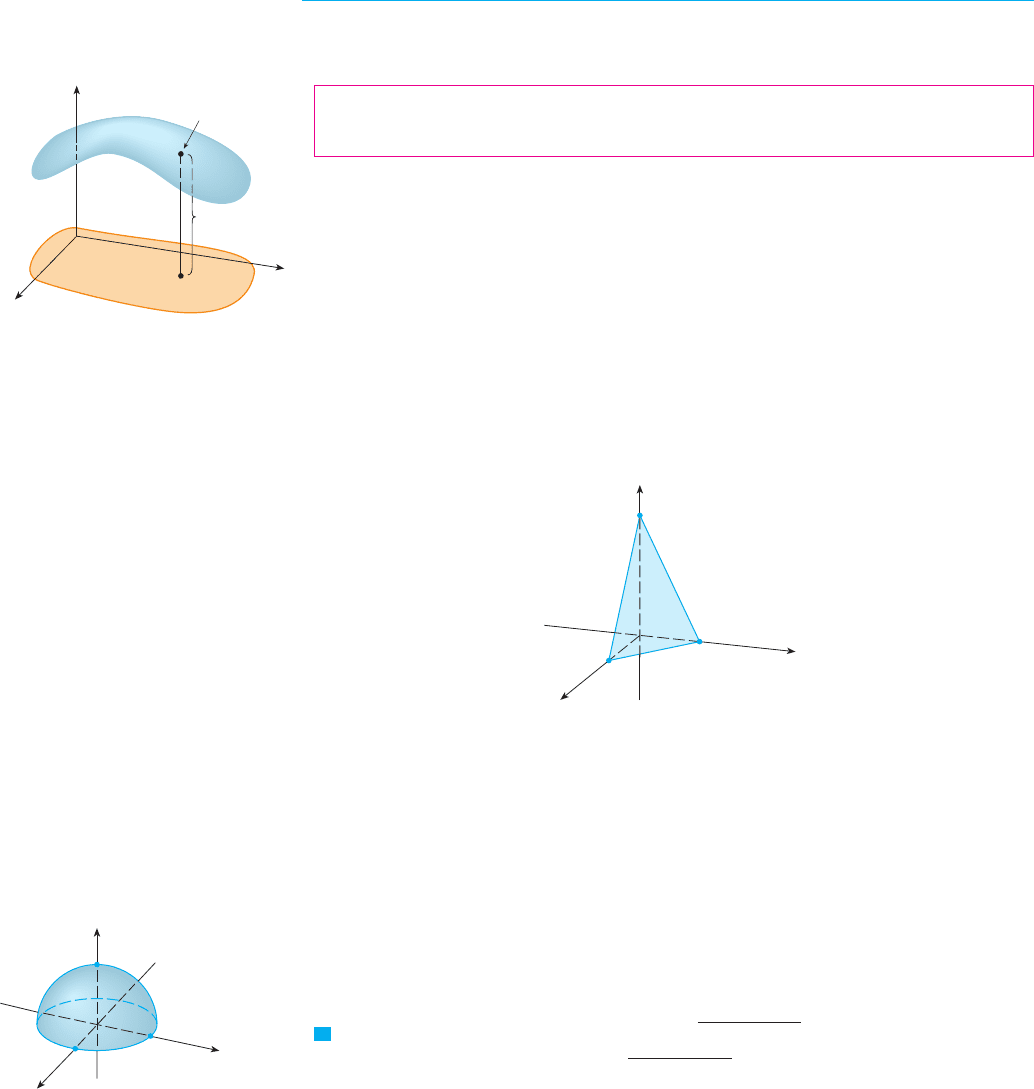
GRAPHS
Another way of visualizing the behavior of a function of two variables is to consider its
graph.
DEFINITION If is a function of two variables with domain D, then the graph of
is the set of all points in such that and is in D.
Just as the graph of a function of one variable is a curve with equation so
the graph of a function of two variables is a surface with equation . We can
visualize the graph of as lying directly above or below its domain in the -plane.
(See Figure 5.)
EXAMPLE 5 Sketch the graph of the function .
SOLUTION The graph of has the equation , or , which
represents a plane. To graph the plane we first find the intercepts. Putting in
the equation, we get as the -intercept. Similarly, the -intercept is 3 and the
-intercept is 6. This helps us sketch the portion of the graph that lies in the first octant.
(See Figure 6.)
M
The function in Example 5 is a special case of the function
which is called a linear function. The graph of such a function has the equation
or
so it is a plane. In much the same way that linear functions of one variable are important
in single-variable calculus, we will see that linear functions of two variables play a central
role in multivariable calculus.
EXAMPLE 6 Sketch the graph of .
SOLUTION The graph has equation . We square both sides of this equa-
tion to obtain , or , which we recognize as an equa-
tion of the sphere with center the origin and radius 3. But, since , the graph of is
just the top half of this sphere (see Figure 7). M
tz 艌 0
x
2
⫹ y
2
⫹ z
2
苷 9z
2
苷 9 ⫺ x
2
⫺ y
2
z 苷
s
9 ⫺ x
2
⫺ y
2
t共x, y兲 苷
s
9 ⫺ x
2
⫺ y
2
V
ax ⫹ by ⫺ z ⫹ c 苷 0z 苷 ax ⫹ by ⫹ c
f 共x, y兲 苷 ax ⫹ by ⫹ c
FIGURE 6
(2,0,0)
(0,3,0)
z
y
x
(0,0,6)
z
yxx 苷 2
y 苷 z 苷 0
3x ⫹ 2y ⫹ z 苷 6z 苷 6 ⫺ 3x ⫺ 2yf
f 共x, y兲 苷 6 ⫺ 3x ⫺ 2y
xyDfS
z 苷 f 共x, y兲Sf
y 苷 f 共x兲,Cf
共x, y兲z 苷 f 共x, y兲⺢
3
共x, y, z兲f
f
894
||||
CHAPTER 15 PARTIAL DERIVATIVES
FIGURE 5
f(x,y)
0
z
y
x
D
S
{
x,y,f(x,y)
}
(x,y,0)
FIGURE 7
Graph of g(x,y)= 9-≈-¥
œ„„„„„„„„„
0
(0,3,0)
(0,0,3)
(3,0,0)
y
z
x
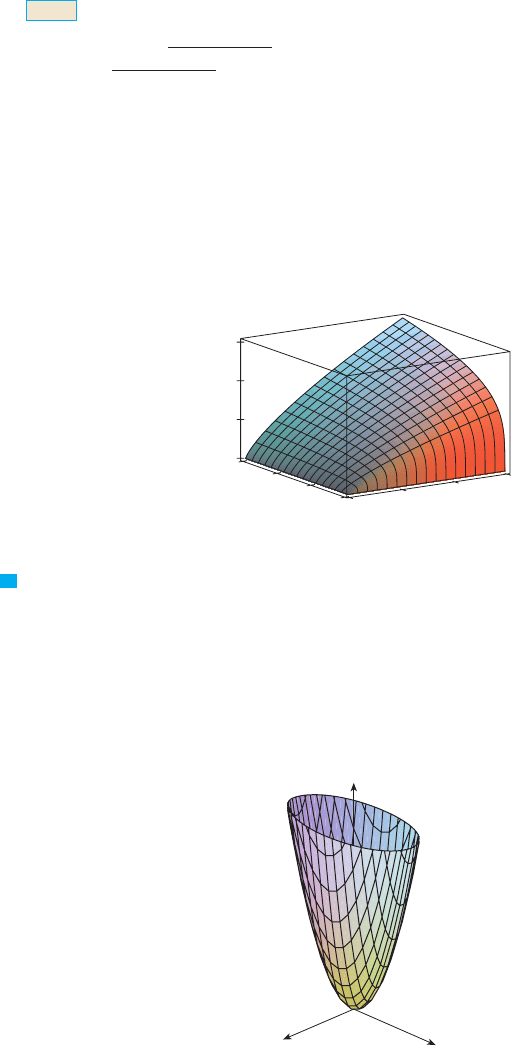
An entire sphere can’t be represented by a single function of and . As we saw
in Example 6, the upper hemisphere of the sphere is represented by the
function . The lower hemisphere is represented by the function
.
EXAMPLE 7 Use a computer to draw the graph of the Cobb-Douglas production function
.
SOLUTION Figure 8 shows the graph of P for values of the labor L and capital K that lie
between 0 and 300. The computer has drawn the surface by plotting vertical traces.
We see from these traces that the value of the production P increases as either L or K
increases, as is to be expected.
M
EXAMPLE 8 Find the domain and range and sketch the graph of .
SOLUTION Notice that is defined for all possible ordered pairs of real numbers ,
so the domain is , the entire xy-plane. The range of h is the set of all nonnega-
tive real numbers. [Notice that and , so for all x and y.]
The graph of h has the equation , which is the elliptic paraboloid that
we sketched in Example 4 in Section 13.6. Horizontal traces are ellipses and vertical
traces are parabolas (see Figure 9).
M
Computer programs are readily available for graphing functions of two variables. In
most such programs, traces in the vertical planes and are drawn for equally
spaced values of and parts of the graph are eliminated using hidden line removal.k
y 苷 kx 苷 k
FIGURE 9
Graph of h(x,y)=4≈+¥
z
y
x
z 苷 4x
2
⫹ y
2
h共x, y兲 艌 0y
2
艌 0x
2
艌 0
关0, ⬁兲⺢
2
共x, y兲h共x, y兲
h共x, y兲 苷 4x
2
⫹ y
2
V
0
100
200
300
L
100
0
200
300
K
0
100
200
300
P
FIGURE 8
P共L, K兲 苷 1.01L
0.75
K
0.25
h共x, y兲 苷 ⫺
s
9 ⫺ x
2
⫺ y
2
t共x, y兲 苷
s
9 ⫺ x
2
⫺ y
2
x
2
⫹ y
2
⫹ z
2
苷 9
yx
NOTE
SECTION 15.1 FUNCTIONS OF SEVERAL VARIABLES
||||
895
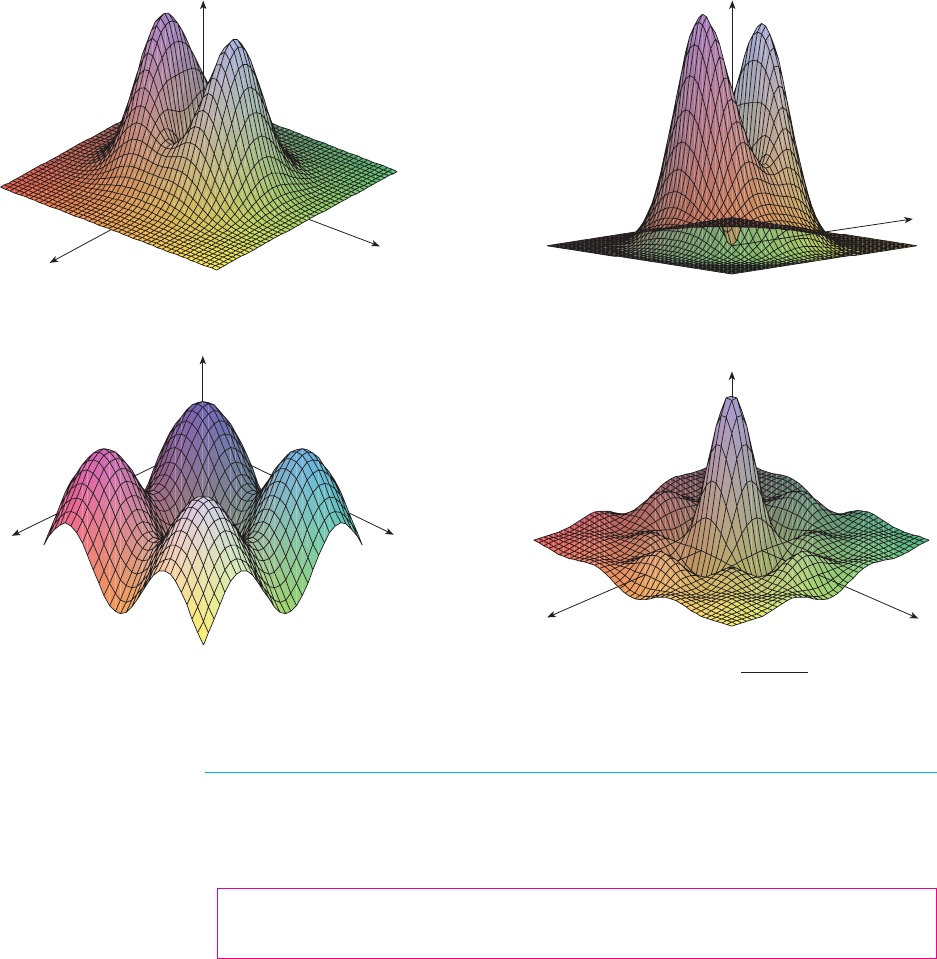
Figure 10 shows computer-generated graphs of several functions. Notice that we get an
especially good picture of a function when rotation is used to give views from different
vantage points. In parts (a) and (b) the graph of is very flat and close to the -plane
except near the origin; this is because is very small when or is large.
LEVEL CURVES
So far we have two methods for visualizing functions: arrow diagrams and graphs. A third
method, borrowed from mapmakers, is a contour map on which points of constant eleva-
tion are joined to form contour curves, or level curves.
DEFINITION The level curves of a function of two variables are the curves with
equations , where is a constant (in the range of ).
A level curve is the set of all points in the domain of at which takes on
a given value . In other words, it shows where the graph of has height .
You can see from Figure 11 the relation between level curves and horizontal traces. The
level curves are just the traces of the graph of in the horizontal plane
projected down to the -plane. So if you draw the level curves of a function and visual-
ize them being lifted up to the surface at the indicated height, then you can mentally piece
xy
z 苷 kff 共x, y兲 苷 k
kfk
fff 共x, y兲 苷 k
fkf 共x, y兲 苷 k
f
FIGURE 10
(c) f(x,y)=sinx+siny
z
x
y
x
z
y
(d) f(x,y)=
sinx siny
xy
(a) f(x,y)=(≈+3¥)e
_≈_¥
z
y
x
(b) f(x,y)=(≈+3¥)e
_≈_¥
x
z
yxe
⫺x
2
⫺ y
2
xyf
896
||||
CHAPTER 15 PARTIAL DERIVATIVES
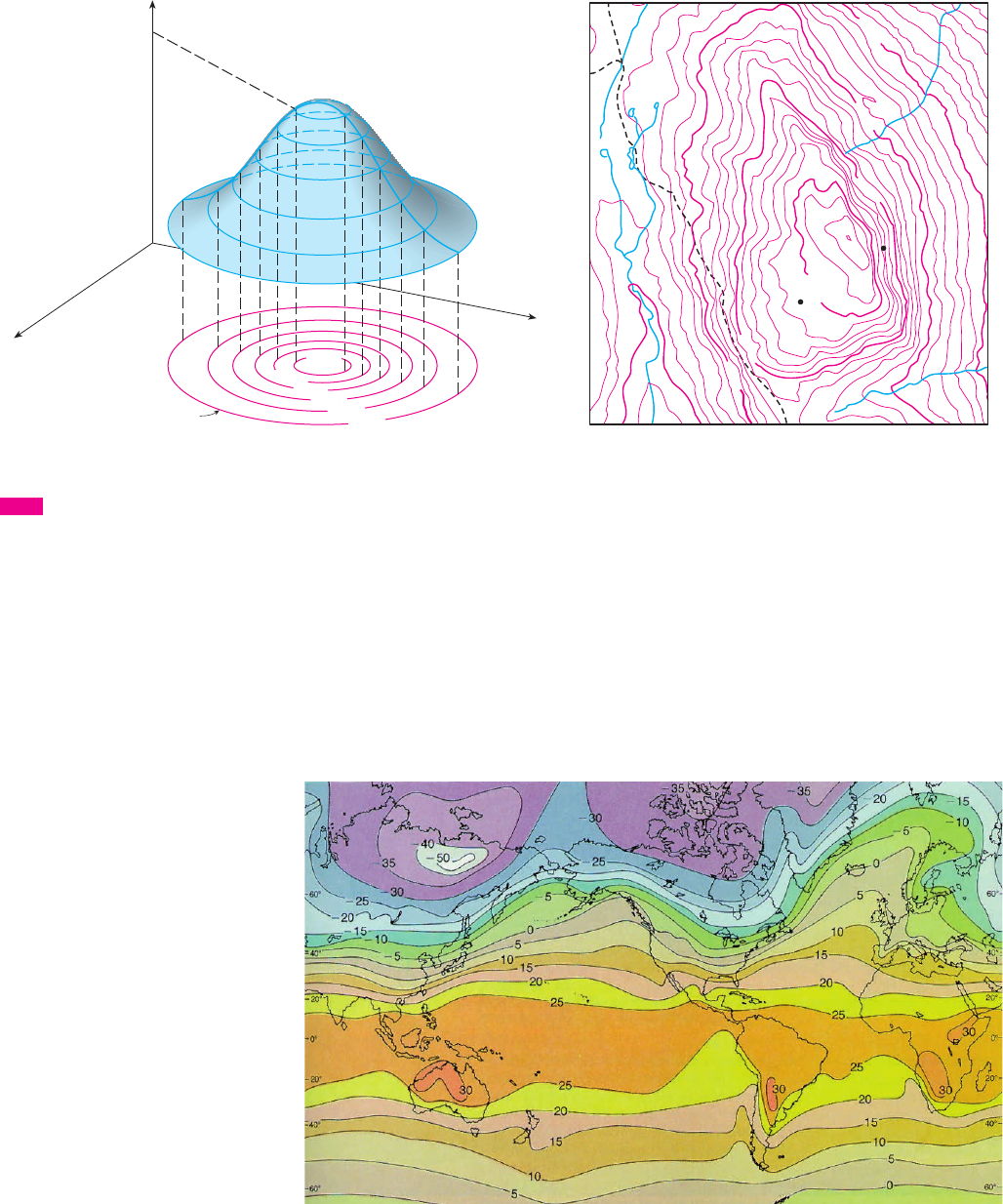
together a picture of the graph. The surface is steep where the level curves are close
together. It is somewhat flatter where they are farther apart.
One common example of level curves occurs in topographic maps of mountainous
regions, such as the map in Figure 12. The level curves are curves of constant elevation
above sea level. If you walk along one of these contour lines, you neither ascend nor descend.
Another common example is the temperature function introduced in the opening paragraph
of this section. Here the level curves are called isothermals and join locations with the
same temperature. Figure 13 shows a weather map of the world indicating the average
January temperatures. The isothermals are the curves that separate the colored bands. The
isobars in the atmospheric pressure map on page 890 provide another example of level
curves.
FIGURE 13
World mean sea-level temperatures
in January in degrees Celsius
Tarbuck,
Atmosphere: Introduction to Meteorology,
4th Edition,
© 1989. Reprinted by permission of Pearson Education, Inc.,
Upper Saddle River, NJ.
FIGURE 11
y
x
0
z
45
k=35
k=40
k=20
k=25
k=30
k=45
f(x,y)=20
LONESOME MTN.
5000
4
5
0
0
4500
4
0
0
0
5
0
0
0
5500
L
o
n
e
s
o
m
e
C
r
e
e
k
A
B
FIGURE 12
SECTION 15.1 FUNCTIONS OF SEVERAL VARIABLES
||||
897
Visual 15.1A animates Figure 11
by showing level curves being lifted up
to graphs of functions.
TEC

EXAMPLE 9 A contour map for a function is shown in Figure 14. Use it to estimate the
values of and .
SOLUTION The point (1, 3) lies partway between the level curves with -values 70 and 80.
We estimate that
Similarly, we estimate that
M
EXAMPLE 10 Sketch the level curves of the function for the
values , , , .
SOLUTION The level curves are
This is a family of lines with slope . The four particular level curves with
, , , and are , , , and
. They are sketched in Figure 15. The level curves are equally spaced
parallel lines because the graph of is a plane (see Figure 6). M
EXAMPLE 11 Sketch the level curves of the function
SOLUTION The level curves are
This is a family of concentric circles with center and radius . The cases
, , , are shown in Figure 16. Try to visualize these level curves lifted up to
form a surface and compare with the graph of (a hemisphere) in Figure 7. (See TEC
Visual 15.1A.)
M
EXAMPLE 12 Sketch some level curves of the function .
SOLUTION The level curves are
x
2
k兾4
⫹
y
2
k
苷 1or4x
2
⫹ y
2
苷 k
h共x, y兲 苷 4x
2
⫹ y
2
y
x0
k=3
k=2
k=1
k=0
(3,0)
FIGURE 16
Contour map of g(x,y)=œ„„„„„„„„„
9-≈-¥
t
321k 苷 0
s
9 ⫺ k
2
共0, 0兲
x
2
⫹ y
2
苷 9 ⫺ k
2
or
s
9 ⫺ x
2
⫺ y
2
苷 k
k 苷 0, 1, 2, 3fort共x, y兲 苷
s
9 ⫺ x
2
⫺ y
2
V
f
3x ⫹ 2y ⫹ 6 苷 0
3x ⫹ 2y 苷 03x ⫹ 2y ⫺ 6 苷 03x ⫹ 2y ⫺ 12 苷 01260k 苷 ⫺6
⫺
3
2
3x ⫹ 2y ⫹ 共k ⫺ 6兲 苷 0or6 ⫺ 3x ⫺ 2y 苷 k
1260k 苷 ⫺6
f 共x, y兲 苷 6 ⫺ 3x ⫺ 2y
f 共4, 5兲⬇56
f 共1, 3兲⬇73
z
f 共4, 5兲f 共1, 3兲
f
898
||||
CHAPTER 15 PARTIAL DERIVATIVES
FIGURE 14
FIGURE 15
Contour map of
f(x,y)=6-3x-2y
y
x0
1
1
2
3
4
5
2345
50
50
60
70
80
60
70
80
x
y
0
k=
12
k=
6
k=
0
k=
_6

which, for , describes a family of ellipses with semiaxes and . Figure 17(a)
shows a contour map of h drawn by a computer with level curves corresponding to
. Figure 17(b) shows these level curves lifted up to the graph
of h (an elliptic paraboloid) where they become horizontal traces. We see from Figure 17
how the graph of h is put together from the level curves.
M
EXAMPLE 13 Plot level curves for the Cobb-Douglas production function of Example 3.
SOLUTION In Figure 18 we use a computer to draw a contour plot for the Cobb-Douglas
production function
Level curves are labeled with the value of the production P. For instance, the level curve
labeled 140 shows all values of the labor L and capital investment K that result in a pro-
duction of . We see that, for a fixed value of P, as L increases K decreases, and
vice versa.
M
For some purposes, a contour map is more useful than a graph. That is certainly true in
Example 13. (Compare Figure 18 with Figure 8.) It is also true in estimating function val-
ues, as in Example 9.
P 苷 140
FIGURE 18
100
100
200
300
K
L
200 300
100
140
180
220
P共L, K兲 苷 1.01L
0.75
K
0.25
FIGURE 17
The graph of h(x,y)=4≈+¥
is formed by lifting the level curves.
(a) Contour map
x
y
y
z
x
(b) Horizontal traces are raised level curves
k 苷 0.25, 0.5, 0.75, ..., 4
s
k
s
k
兾2k ⬎ 0
SECTION 15.1 FUNCTIONS OF SEVERAL VARIABLES
||||
899
Visual 15.1B demonstrates the
connection between surfaces and their
contour maps.
TEC
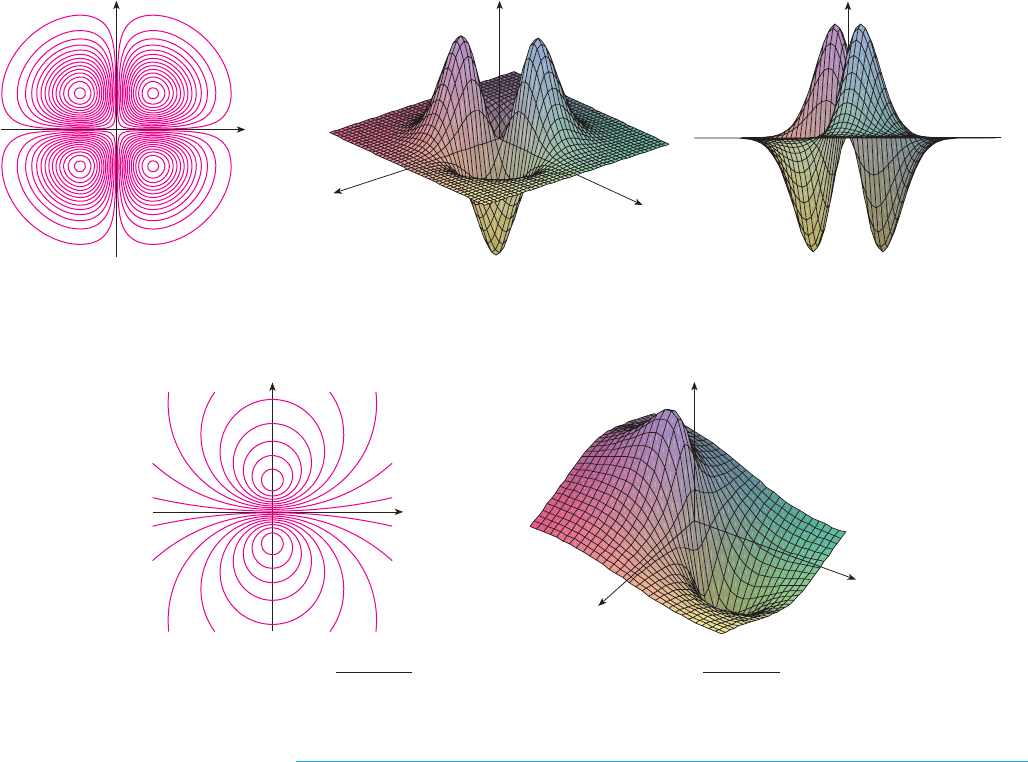
Figure 19 shows some computer-generated level curves together with the corresponding
computer-generated graphs. Notice that the level curves in part (c) crowd together near the
origin. That corresponds to the fact that the graph in part (d) is very steep near the origin.
FUNCTIONS OF THREE OR MORE VARIABLES
A function of three variables, , is a rule that assigns to each ordered triple in a
domain a unique real number denoted by . For instance, the temperature
at a point on the surface of the earth depends on the longitude x and latitude y of the
point and on the time t, so we could write .
EXAMPLE 14 Find the domain of if
SOLUTION The expression for is defined as long as , so the domain of
is
This is a half-space consisting of all points that lie above the plane .
M
z 苷 y
D 苷 兵共x, y, z兲 僆 ⺢
3
ⱍ
z y其
fz y 0f 共x, y, z兲
f 共x, y, z兲 苷 ln共z y兲 xy sin z
f
T 苷 f 共x, y, t兲
T
f 共x, y, z兲D 傺 ⺢
3
共x, y, z兲f
FIGURE 19
(a) Level curves of f(x,y)=_xye
_≈_¥
x
y
(c) Level curves of f(x,y)=
_3y
≈+¥+1
y
x
(d) f(x,y)=
_3y
≈+¥+1
z
y
x
(b) Two views of f(x,y)=_xye
_≈_¥
z
y
x
z
900
||||
CHAPTER 15 PARTIAL DERIVATIVES

It’s very difficult to visualize a function of three variables by its graph, since that
would lie in a four-dimensional space. However, we do gain some insight into by exam-
ining its level surfaces, which are the surfaces with equations , where is
a constant. If the point moves along a level surface, the value of remains
fixed.
EXAMPLE 15 Find the level surfaces of the function
SOLUTION The level surfaces are , where . These form a family of
concentric spheres with radius . (See Figure 20.) Thus, as varies over any
sphere with center , the value of remains fixed. M
Functions of any number of variables can be considered. A function of n variables
is a rule that assigns a number to an -tuple of real
numbers. We denote by the set of all such n-tuples. For example, if a company uses
different ingredients in making a food product, is the cost per unit of the ingredient,
and units of the ingredient are used, then the total cost of the ingredients is a func-
tion of the variables :
The function is a real-valued function whose domain is a subset of . Sometimes we
will use vector notation to write such functions more compactly: If ,
we often write in place of . With this notation we can rewrite the
function defined in Equation 3 as
where and denotes the dot product of the vectors c and x in .
In view of the one-to-one correspondence between points in and
their position vectors in , we have three ways of looking at a func-
tion f defined on a subset of :
1. As a function of real variables
2. As a function of a single point variable
3. As a function of a single vector variable
We will see that all three points of view are useful.
x 苷 具x
1
, x
2
, ..., x
n
典
共x
1
, x
2
, ..., x
n
兲
x
1
, x
2
, ..., x
n
n
⺢
n
V
n
x 苷 具x
1
, x
2
, ..., x
n
典
⺢
n
共x
1
, x
2
, ..., x
n
兲
V
n
c ⴢ xc 苷 具c
1
, c
2
, ..., c
n
典
f 共x兲 苷 c ⴢ x
f 共x
1
, x
2
, ..., x
n
兲f 共x兲
x 苷 具x
1
, x
2
, ..., x
n
典
⺢
n
f
C 苷 f 共x
1
, x
2
, ..., x
n
兲 苷 c
1
x
1
c
2
x
2
c
n
x
n
3
x
1
, x
2
, ..., x
n
n
Cithx
i
ithc
i
n⺢
n
共x
1
, x
2
, ..., x
n
兲nz 苷 f 共x
1
, x
2
, ..., x
n
兲
f 共x, y, z兲O
共x, y, z兲
s
k
k 0x
2
y
2
z
2
苷 k
f 共x, y, z兲 苷 x
2
y
2
z
2
f 共x, y, z兲共x, y, z兲
kf 共x, y, z兲 苷 k
f
f
SECTION 15.1 FUNCTIONS OF SEVERAL VARIABLES
||||
901
FIGURE 20
≈+¥+z@=9
x
y
z
≈+¥+z@=1
≈+¥+z@=4
(c) Describe in words the meaning of the question “For what
value of T is ?” Then answer the question.
(d) What is the meaning of the function ?
Describe the behavior of this function.
(e) What is the meaning of the function ?
Describe the behavior of this function.
W 苷 f 共T, 50兲
W 苷 f 共5,
v兲
f 共T, 20兲 苷 49
In Example 2 we considered the function , where
W is the wind-chill index, T is the actual temperature, and is
the wind speed. A numerical representation is given in Table 1.
(a) What is the value of ? What is its meaning?
(b) Describe in words the meaning of the question “For what
value of is ?” Then answer the question.f 共20,
v兲 苷 30v
f 共15, 40兲
v
W 苷 f 共T, v兲
1.
EXERCISES
15.1
